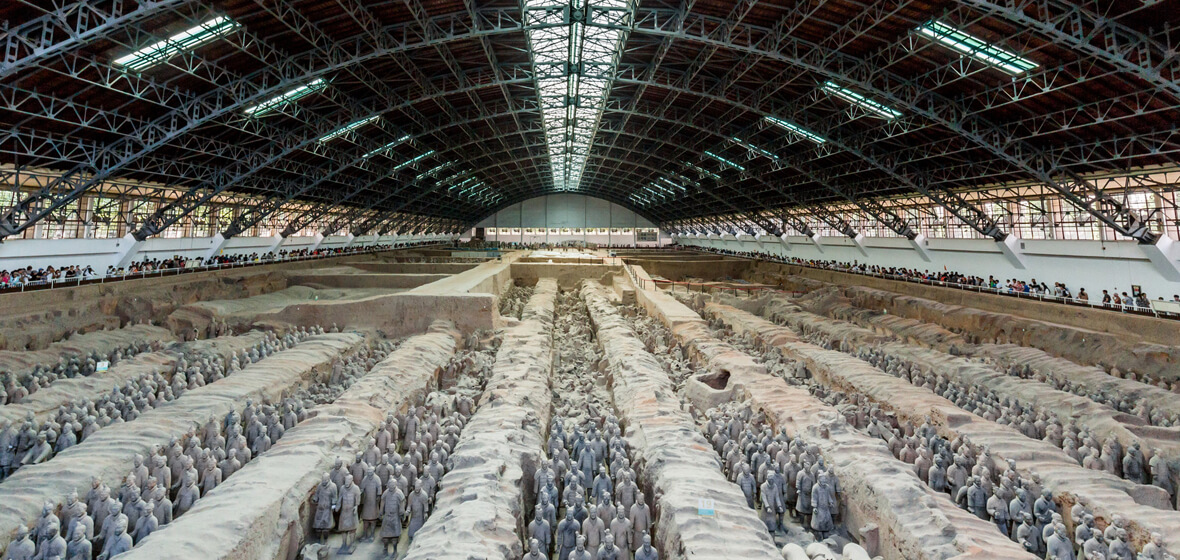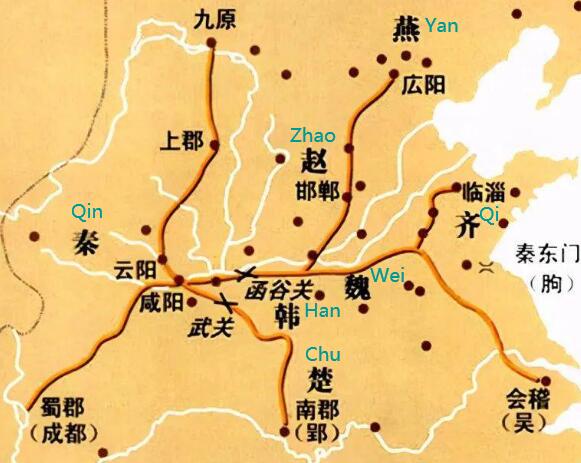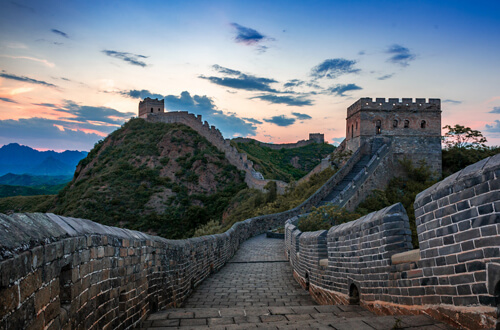The Greatest Dynasties in China: Qin Dynasty

Qin was a regional state of the Zhou period (1046-256 BCE). As a relatively backward state located far in the west, Qin was incorporated into the system of regional states of the Zhou dynasty at a relatively late point of time (770 BCE), and yet a series of competent advisors helped Qin to become the strongest of the "Warring States" (c.475-221 BCE) in the late Zhou period. During the Warring States period, at least seven kingdoms battled for supremacy in east-central China. By 221 BCE, Qin had conquered or subjugated most of the East Asian subcontinent, putting an end to centuries of turmoil, warfare, and bloodshed between the Warring States. The king of Qin declared himself the First Emperor (Qin Shi Huangdi) and proclaimed that warfare would never arise again. He hoped to establish a lengthy age of orderly rule, universal compliance, and prosperity for all. Although these goals were not fully realized, the emperor and his aides were able to lay the institutional and ideological foundations of all later Chinese empires in just a few years. Despite ongoing resistance to Qin's rule among some of the new subjects, this laid the basis for the most durable succession of imperial polities worldwide.
The Qin Empire, also known as Ch'in, is likely where the name China originates.
The Facts of the Qin Dynasty
The Notable Persons of Qin Dynasty
Qin Shi Huangdi

Born Ying Zheng, or Zhao Zheng, he ascended to the throne at the age of 13. Qin Shi Huangdi was the first emperor of the Qin Dynasty and is considered one of the most important figures in Chinese history. He is known for his military conquests, his unification of China, and his construction of the Great Wall of China. He also implemented a series of reforms, including standardizing weights and measures, currency, and writing. Instead of the enfeoffment system, he divided the lands into 36 command areas, each supervised by a governor, a military commander, and an imperial inspector, all of whom reported to him. He relocated hundreds of thousands of influential families from their home provinces to the capital, Xianyang, where he could keep a close eye on them. Shi Huangdi became obsessed with the idea of immortality at around 40 years old. He sought immortality through a variety of elixirs. Ironically, some of these elixirs may have contributed to his death in 210 BCE. After his death, the empire collapsed quickly.
Li Si
A native of the state of Chu, Li Si was a prominent politician and statesman during the Qin Dynasty. He served as the prime minister under Qin Shi Huang and was responsible for implementing many of the emperor's policies, including the standardization of writing and the construction of the Great Wall of China. He was a notable calligrapher. Under Li Si's guidance, Xiaozhuan script (small seal) was standardized and simplified, making it easier to read and write. This helped to promote literacy and education throughout the empire and laid the foundation for the development of the Chinese writing system that is still used today.
Meng Tian
Meng Tian was a general and military strategist during the Qin Dynasty, and he played a significant role in the construction of the Great Wall of China. The construction of the Great Wall of China began during the 7th century BCE, long before the Qin Dynasty. However, it was during the Qin Dynasty that the wall was significantly expanded and connected into a continuous fortification that stretched for thousands of miles. During the reign of the first emperor of the Qin Dynasty, Meng Tian was appointed as the general in charge of overseeing the construction of the Great Wall. He was responsible for organizing the labor force, supervising the construction work, and defending the wall against attacks from nomadic tribes in the north.
Shang Yang
Also known as Zhao Gou, son of emperor Huizong, was the ninth emperor of the Song Dynasty in China. He was born in 1107 CE and ruled from 1127 CE until his death in 1162 CE. He was the first emperor of the Southern Song period, which began after the fall of the Northern Song Dynasty to the Jurchen Jin Dynasty.
Born c. 390 BCE in Wei state and died 338 BCE, Shang Yang was a philosopher and statesman who served as the chief minister under Duke Xiao of Qin. He implemented a series of legal reforms, including the establishment of a strict legal code and the abolition of feudalism. He divided the entire countryside into a rectangular grid, the entire population into military units, and the administration into military districts; and then he mapped the individual households of the population onto the grid in accordance with merits earned in battle or through agriculture. This identity of military and civil order and the dedication of the entire society to military conquest were hallmarks of the Warring States period and the foundation on which the first empire was built.
Lv Buwei
A wealthy merchant, politician, and advisor to the ruler of the state of Qin, he played a significant role in the rise of the Qin Dynasty. Lv Buwei is perhaps best known for his role in the creation of the famous Lvshi Chunqiu (“The Spring and Autumn Annals of Mr. Lv”), a compendium of folklore and pseudoscientific and Daoist writings. Despite his contributions to the rise of the Qin Dynasty, Lv Buwei's reputation was tarnished by his involvement in a scandal involving Queen Zhao Ji (mother of Qin Shi Huangdi). He was forced to flee the state of Qin and spent the rest of his life in exile.
Zhao Tuo
Zhao Tuo was a general who served under the Qin Dynasty but later rebelled and established the independent kingdom of Nanyue in southern China in what is now modern-day Guangdong, Guangxi, and northern Vietnam. He is known for his military campaigns against the Vietnamese and for his efforts to promote Chinese culture in the region. He also established a system of government that was based on the Chinese model, with a centralized bureaucracy and a system of taxation.
What is the Qin Dynasty Known for?
The Qin Dynasty is known for several significant achievements and innovations that had a lasting impact on Chinese history and culture. Here are some of the most notable things that the Qin Dynasty is known for:
Unification of China

The Qin Dynasty was the first dynasty to unify China under a single ruler. This was achieved through a series of military campaigns and political reforms that brought together the various warring states of China.
Hydraulic Engineering
Lingqu Canal: In 214 BCE, Qin Shi Huang, in order to attack the Baiyue tribes in the south, ordered the construction of a canal connecting the Xiang and the Li rivers. The 36.4 km canal joins the Yangtze River Basin and Pearl River Basin and links up Central China and Lingnan region. The Canal has been in service for over 2000 years as the major water transport route between Lingnan (today’s Guangdong and Guangxi) and Central China until the completion of the Yuehan Railway and Xianggui Railway in modern times.

Dujiangyan Irrigation System: The Dujiangyan Irrigation System is an ancient irrigation system located in the Sichuan province of China. It was built by Li Bing, a governor of the region, and his son. The Dujiangyan Irrigation System is considered a marvel of engineering and is still in use today, over 2,000 years after it was built. The system consists of a series of canals, dams, and levees that divert water from the Min River to irrigate the surrounding farmland.
Zhengguo Canal: The canal was first constructed in 246 BCE, named after its designer Zheng Guo. It is a large canal located in the northern part of the Guanzhong plain in northwest China's Shaanxi province. It irrigated approximately 27,000 square kilometers of additional agricultural land, providing the Qin dynasty with sufficient resources to increase the size of its already massive armies.
National Road System
 National Road System
National Road System The Qin Empire is known for its engineering marvels, including a complex system of over 4,000 miles of road and one superhighway, the Qinzhidao (Straight Road), which is about 900 kilometers long and 30 to 50 meters wide, starting from Tiewang township at Chunhua to Jiuyuanjun, a place near Baotou, Inner Mongolia autonomous region. It is the pathway on which materials for the Great Wall of China were transported.
Standardization
Before Qin united China, every state had its own weights and measures, currency, and writing standards. The Qin Dynasty implemented a series of standardizations, including weights and measures, currency, and writing.
One of the most significant standardizations implemented by the Qin Dynasty was the standardization of weights and measures. This helped to promote trade and commerce throughout the empire and made it easier for people to conduct business across different regions.
The Qin Dynasty also standardized currency, which helped to promote economic stability and made it easier for people to conduct transactions across different regions. This helped to promote economic growth and prosperity throughout the empire.
Another significant standardization implemented by the Qin Dynasty was the standardization of writing. The Chinese language had been written in a variety of different scripts before the Qin Dynasty, but Qin Shi Huang ordered the creation of a standardized script that would be used throughout the empire. This helped to promote literacy and education throughout the empire and laid the foundation for the development of the Chinese writing system that is still used today.

Great Wall of China
The Qin Dynasty is known for its construction of the Great Wall of China, a massive fortification that was built to protect the northern borders of the empire.
Terracotta Army
The Qin Dynasty is also known for its Terracotta Army, a collection of life-sized terracotta sculptures that were buried with the first emperor of the Qin Dynasty. These sculptures are considered one of the greatest archaeological discoveries of the 20th century.
Where Can I See the Influence of the Qin Dynasty Today?
Great Wall of China: The Great Wall of China, which was built during the Qin Dynasty, is still one of the most iconic landmarks in China. It is a popular tourist destination and a symbol of China's rich history and culture.
Terracotta Army in Xi’an: The Terracotta Army, which was also created during the Qin Dynasty, is another popular tourist attraction in China. It is considered one of the greatest archaeological discoveries of the 20th century and is a testament to the artistic and technological achievements of the Qin Dynasty.
Dujiangyan Irrigation System: It is one of the oldest irrigation systems in the world. It is also the only surviving monumental non-dam irrigation system from the ancient past. It is just 60 km from Chengdu in Sichuan Province.
Lingqu Canal: It connects Xiang River and Li River, joins the Yangtze River Basin and Pearl River Basin and has been in service for over 2000 years as the major water transport route. It is about 80 km from Guilin City in southern China.

OR
Are you eager to begin your Chinese cultural journey?
Drop us a line and we will promptly connect you with our leading China expert!